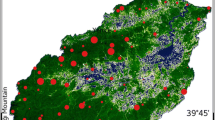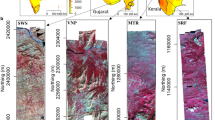Abstract
There is an urgent need to obtain an accurate data on biological diversity and its temporal variation, in order to adopt an appropriate protection strategy to manage the urban forest remnants on sustainable manner for future generations. RapidEye Satellite images with spatial resolution of 5 × 5 m (orthorectified pixel size), ASTER VNIR images with spatial resolution of 15 × 15 m and Landsat-8 OLI images with spatial resolution of 30 × 30 m were used to evaluate the woody species diversity in urban forest remnants. Pearson Correlation Coefficient (PCC) was used to determine the relationships between the woody species diversity at Alpha (α) level and the spectral & texture properties derived from the satellite images. PCC test showed a positive significant relationship between the brightness of the RapidEye satellite image (i.e., Atmospherically Resistant Vegetation Index; ARVI) and the Simpson’s Diversity Index (S) (r = 0.80, p < 0.01). In order to also estimate the beta (β) diversity in the study, the relationship between species rarefaction curves and spectral rarefaction curves was calculated through multiple regression analysis i.e., Landsat NDVI, ASTER NDVI and RapidEye NDVI (respectively, R2 = 0.99; 0.99; 0.98, p < 0.01). The findings of the study revealed that satellite image with a resolution of 5 m would be more appropriate to estimate the woody species diversity of urban forest remnants. However, medium resolution satellite images (Landsat) may be used to examine the species rarefaction curve and β diversity in forest remnants.





Similar content being viewed by others
References
Adam, E. M., Mutanga, O., Rugege, D., & Ismail, R. (2012). Discriminating the Papyrus Vegetation (Cyperus papyrus L.) and its co-Existent Species Using Random Forest and Hyperspectral Data Resampled to HYMAP. International Journal of Remote Sensing, 33(2), 552–569.
Alvey, A. A. (2006). Promoting and Preserving Biodiversity in the Urban Forest. Urban Foresry & Urban Greening, 5(4), 195–201.
Ardila, J. P., Bijker, W., Tolpekin, V. A., & Stein, A. (2012). Context-Sensitive Extraction of Tree Crown Objects in Urban Areas Using VHR Satellite Images. International Journal of Applied Earth Observation and Geoinformation, 15, 57–69.
Asan, U., Özkan, U. Y., Zengin, H., & Sağlam, S. (2007). Principals of Application of Ecosystem Based Functional Planning Approach in City Groves. In Proceedings of Bottlenecks, Solutions, and Priorities in the Context of Functions of Forest Resources International Symposium, Istanbul, pp. 227–242.
Bagnall, R. G. (1979). A Study of Human Impact on a Urban Forest Remnant: Redwood Bush, Tawa, near Wellington, New Zealand. New Zeland Journal of Botany, 17(2), 117–126.
Battles, J. J., Shlisky, A. J., & Barrett, R. H. (2001). The Effects of Forest Management on Plant Species Diversity in a Sierran Conifer Forest. Forest Ecology and Management, 146(1), 211–222.
Bawa, K., Rose, J., Ganeshaiah, K. N., Barve, N., Kiran, M. C., & Umashaanker, R. (2002). Assessing Biodiversity from Space: An Example from the Western Ghats, India. Conservation Ecology, 6(2), 7.
Cayuela, L., Benayas, J. M., Justel, A., & Salas-Rey, J. (2006). Modelling Tree Diversity in a Highly Fragmented Tropical Montane Landscape. Global Ecology and Biogeography, 15, 602–613.
Crippen R. E. (1990). Calculating the vegetation index faster. Remote Sensing of Environment, 00334(1),71–73.
Definiens, A. G. (2006). Definiens professional 5 reference book. Munich: Definiens AG.
Dian, Y., Li, Z., & Pang, Y. (2015). Spectral and Texture Features Combined for Forest Tree speciesClassification with Airborne Hyperspectral Imagery. Journal of the Indian Society of Remote Sensing, 43(1), 101–107.
Fairbanks, D. H. K., & McGwire, K. C. (2004). Patterns of Floristic Richness in Vegetation Communities of California: Regional Scale Analysis with Multi-Temporal NDVI. Global Ecology and Biogeography, 13, 221–235.
Forman, R. T. T. (2014). Urban ecology: Science of cities. Cambridge. Cambridge University Press.
Gadow, K. V., & Hui G. (2002). Characterising forest spatial structure and diversity. In Proceedings of in Sustainable Forestry in Temperate Regions. Proceedings of the SUFOR International Workshop, Lund University, pp. 20–30.
Gillespie, T. W., Foody, G. M., Rocchini, D., Giorgi, A. P., & Saatchi, S. (2008). Measuring and Modelling Biodiversity from Space. Progress in Physical Geography, 32(2), 203–221.
Harralick, R. M., Shanmugam, K., & Dinstein, I. (1973). Textural Features for Images Classification. Systems, Man and Cybernetics, IEEE Transactions on, 6, 610–621.
Hung, M. C. (2002). Urban Land Cover Analysis from Satellite Images. Pecora 15/Land Satellite Information IV/ISPRS Comission I/FIEOS 2002 Conference Proceesings. http://www.isprs.org/proceedings/XXXIV/part1/Paper/00099.pdf. Accessed 15 January 2015.
Jensen, J. R., & Lulla, K. (1996). Introductory digital image processing, a remote sensing perspective. New Jersey: Taylor & Francis.
Kalayci, S. (2006). SPSS uygulamalı Çok değişkenli istatistik teknikler. Ankara: Asil yayın Dağıtım.
Kark, S., & Dearborn, D. C. (2009). Motivations for Conserving Urban Biodiversity. Conservation Biology, 24(2), 432–440.
Kaufman, Y. J., & Tanre, D. (1992). Atmospherically Resistant Vegetation Index (ARVI) for EOS-MODIS. IEEEE Transactions. Geoscience. Remote Sensing., 30(2), 261–270.
Kayitakire, F., Hamel, C., & Defourny, P. (2006). Retrieving Forest Structure Variables Based on Image Texture Analysis and IKONOS-2 Imagery. Remote Sensing of Environment, 102(3), 390–401.
Kim, M., Warner, T. A., Madden, M., & Atkinson, D. S. (2011). Multi-Scale GEOBIA with Very High Spatial Resolution Digital Aerial Imagery: Scale, Texture and Image Objects. International Journal of Remote Sensing, 32(10), 2825–2850.
Kong, F., Yin, H., & Nakagoshi, N. (2007). Using GIS and Landscape Metrics in the Hedonic Price Modeling of the Amenity Value of Urban Green Space: A Case Study in Jinan City, China. Landscape Urban Planning, 79, 240–252.
Konijnendijk, C. C. (2005). New perspectives for urban forests: Introducing wild woodlands. In I. Kowaric, & S. Körner (Eds.), Wild urban woodlands (pp. 33–45). New York: Springer.
Levin, N., Shmida, A., Levanoni, O., Tamari, H., & Kark, S. (2007). Predicting Mountain Plant Richness and Rarity from Space Using Satellite-Derived Vegetation Indices. Diversity and Distributions, 13(6), 692–703.
Luoto, M., Toivonen, T., & Heikkinen, R. K. (2002). Prediction of Total and Rare Plant Species Richness in Agricultural Landscapes from Satellite Images and Topographic Data. Landscape Ecology, 17(3), 195–217.
Mansfield, C., Pattanayak, S. K., McDow, W., McDonald, R., & Halpin, P. (2005). Shades of Green: Measuring the Value of Urban Forests in the Housing Market. Journal of Forest Economics, 11(3), 177–199.
McKinney, M. L. (2002). Urbanization, Biodiversity, and Conservation. Bioscience, 52(10), 883–890.
Moser, D., Zechmeister, H. G., Plutzar, C., Sauberer, N., Wrbka, T., & Grabherr, G. (2002). Landscape Patch Shape Complexity as an Effective Measure for Plant Species Richness in Rural Landscapes. Landscape Ecology, 17(7), 657–669.
Mutowo, G., & Murwira, A. (2012). Relationship Between Remotely Sensed Variables and Tree Species Diversity in Savanna Woodlands of Southern Africa. International Journal of Remote Sensing, 33(20), 6378–6402.
Nagendra, H. (2001). Using Remote Sensing to Assess Biodiversity. International Journal of Remote Sensing, 22(12), 2377–2400.
Oldeland, J., Wesuls, D., Rocchini, D., Schmidt, M., & Jürgens, N. (2010). Does Using Species Abundance Data Improve Estimates of Species Diversity from Remotely Sensed Spectral Heterogeneity? Ecological Indicators, 10(2), 390–396.
Ozdemir, İ., & Donoghue, D. N. M. (2013). Modelling Tree Size Diversity from Airborne Laser Scanning Using Canopy Height Models with Image Texture Measures. Forest Ecology and Management, 295, 28–37.
Ozdemir, I., & Karnieli, A. (2011). Predicting Forest Structural Parameters Using the Image Texture Derived from WorldView-2 Multispectral Imagery in a Dryland Forest, Israel. International Journal of Applied Earth Observation and Geoinformation, 13(5), 701–710.
Ozdemir, I., Norton, D. A., Ozkan, U. Y., Mert, A., & Senturk, O. (2008). Estimation of Tree Size Diversity Using Object Oriented Texture Analysis and Aster Imagery. Sensors, 8, 4709–4724.
Ozdemir, I., Mert, A., & Senturk, O. (2012). Predicting Landscape Structural Metrics Using Aster Satellite Data. Journal of Environmental Engineering and Landscape Management, 20(2), 168–176.
Ozkan, U. Y. (2014). Assessment of Visual Landscape Quality Using IKONOS Imagery. Environmental Monitoring and Assessment, 186(7), 4067–4080.
Petr, P., Zdena, C., Antonin, P., Vojtech, J., Milan, C., & Lubomir, T. (2004). Trends in Species Diversity and Composition of Urban Vegetation over Three Decades. Journal of Vegetation Science, 15(6), 781–788.
Rocchini, D. (2007). Effects of Spatial and Spectral Resolution in Estimating Ecosystem α-Diversity by Satellite Imagery. Remote Sensing of Environment, 111(4), 423–434.
Rocchini, D., Chiarucci, A., & Loiselle, S. A. (2004). Testing the Spectral Variation Hypothesis by Using Satellite Multispectral Images. Acta Oecologica, 26(2), 117–120.
Rocchini, D., Butini, S. A., & Chiarucci, A. (2005). Maximizing Plant Species Inventory Efficiency by Means of Remotely Sensed Spectral Distances. Global Ecology and Biogeography, 14(5), 431–437.
Rocchini, D., Ricotta, C., & Chiarucci, A. (2007). Using Satellite Imagery to Assess Plant Species Richness: The Role of Multispectral System. Applied Vegation Science, 10(3), 325–331.
Rocchini, D., Ricotta, C., Chiarucci, A., De Dominicis, V., Cirillo, I., & Maccherini, S. (2009). Relating Spectral and Species Diversity Through Rarefaction Curves. International Journal of Remote Sensing, 30(10), 2705–2711.
Rocchini, D., McGlinn, D., Ricotta, C., Neteler, M., & Wohlgemuth, T. (2011). Landscape Complexity and Spatial Scale Influence the Relationship Between Remotely Sensed Spectral Diversity and Survey-Based Plant Species Richness. Journal of Vegetation Science, 22(4), 688–698.
Rouse, J. W., Haas, R. H., Jr., Schell, J. A., & Deering, D. W. (1974). Monitoring vegetation systems in the Great Plains with ERTS. In Proceedings of Third ERTS-1 Symposium, Washington DC, pp. 309–317.
Sander, H., Polasky, S., & Haight, R. G. (2010). The Value of Urban Tree Cover: A Hedonic Property Price Model in Ramsey and Dakota Counties, Minnesota, USA. Ecological Economics, 69(8), 1646–1656.
Shannon, C. E., & Weaver, W. (1949). The mathematical theory of communication. Urbana: University of Illinois Press.
Simpson, E. H. (1949). Measurement of Diversity. Nature, 163, 688.
Singh, J. S., Roy, P. S., Murthy, M. S. R., & Jha, C. S. (2010). Application of Landscape Ecology and Remote Sensing for Assessment, Monitoring and Conservation of Biodiversity. Journal of the Indian Society of Remote Sensing, 38(3), 365–385.
Tucker, C. J. (1979). Red and Photographic Infrared Linear Combinations for Monitoring Vegetation. Remote Sensing of Environment, 8, 127–150.
Tyrväinen, L., Pauleit, S., Seeland, K., & Vries, D. (2005). Benefits and uses of urban forests and tree. In C. Konijnendijk,, K. Nilsson, T. Randrup, J. Schipperijn (Ed), In urban forests and trees (pp.81–114). New York: Springer.
Varghese, A. O., Joshi, A. K., & Murthy, Y. K. (2010). Mapping of Realized and Fundamental Niches of Threatened Tree Species Using Geoinformatics: A Species Level Approach for Sustaining Biodiversity. Journal of the Indian Society of Remote Sensing, 38(3), 523–534.
Acknowledgments
This study was supported by the Scientific and Technological Research Council of Turkey (TÜBİTAK) under the project no 114O015. We would like to thank first and foremost TÜBİTAK for its support. Furthermore, we would like to thank Istanbul University, Faculty of Forestry for facilitating our study. We would like to thank Istanbul Metropolitan Municipality for allowing us to perform our study in the urban forest remnants that are under its ownership. Lastly, we thank to Dr. Rajpar Muhammad Nawaz for English editing of our paper.
Author information
Authors and Affiliations
Corresponding author
About this article
Cite this article
Ozkan, U.Y., Ozdemir, I., Saglam, S. et al. Evaluating the Woody Species Diversity by Means of Remotely Sensed Spectral and Texture Measures in the Urban Forests. J Indian Soc Remote Sens 44, 687–697 (2016). https://doi.org/10.1007/s12524-016-0550-0
Received:
Accepted:
Published:
Issue Date:
DOI: https://doi.org/10.1007/s12524-016-0550-0




